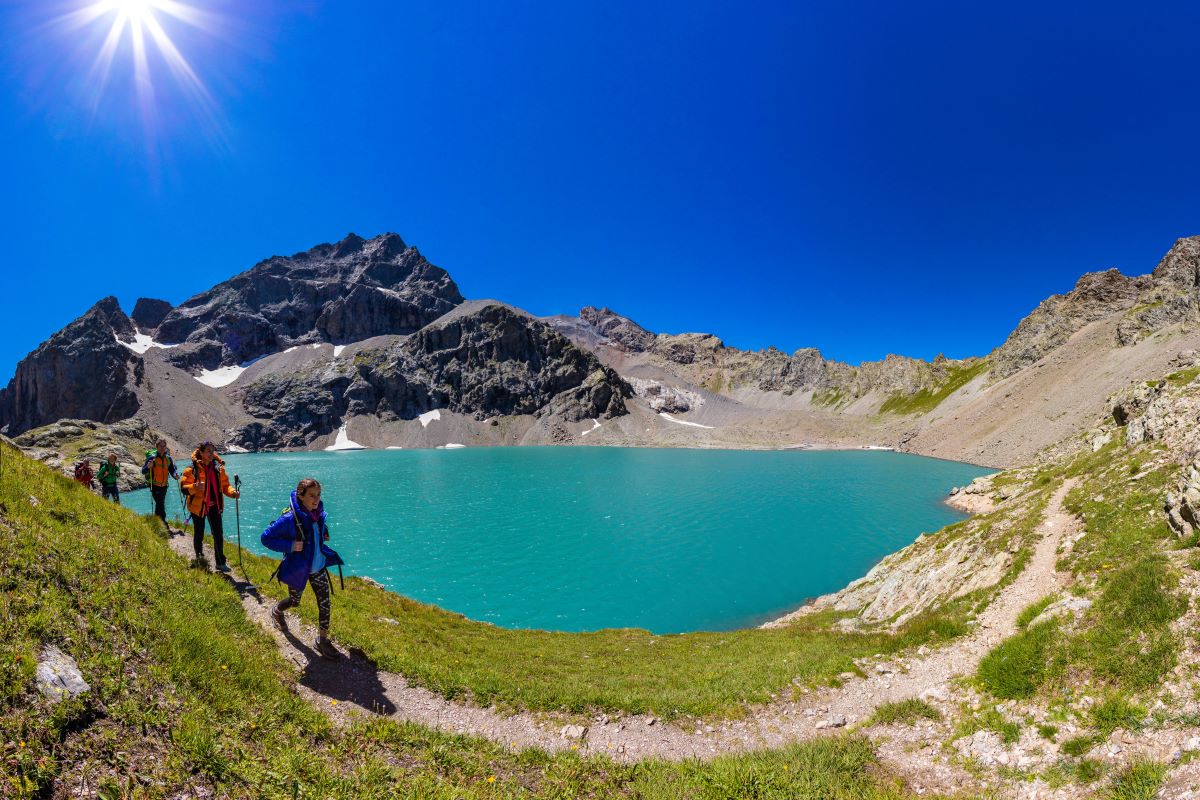
Eychauda Lake
"The winter had been long. At the beginning of July, the lake was still snowy but little by little the ice had melted, dislocated. In this beginning of August I went up saying to myself: right, there, it’s finished, there’s no more ice! But no! In the quietness of morning, icebergs were still floating, debonair. This lake certainly deserves its description as a glacial!"
Marie-Geneviève Nicolas, park ranger in Vallouise
Description
From Chambran car park, follow the track which leads to the bottom of the valley. Further along, it leaves on the right a track to the Eychauda mountain pass.
- After a big walkway over the torrent, follow the trail which passes not far from the pastoral cabin. The track gently rises in the bottom of the top the foot of the rocky ridge. It bends upwards, first over a large scree slope then flowered grass land. A small lower shelf and there is the lake, well hidden behind its cross cliff. It nestles at the bottom of the glacial cirque surrounded by high ridges.
- Return using the same itinerary.
- Departure : Chambran Hamlet
- Towns crossed : Vallouise-Pelvoux
17 points of interest
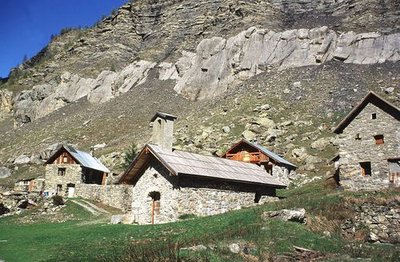
Le hameau de Chambran - Marie-Geneviève Nicolas - PNE  History
HistoryChambran Hamlet
At an altitude of 1700 meters, this hamlet is inhabited in summer, at the beginning of the summer pasture. The old dairy has been spruced up to become a snack bar. It’s pretty little chapel dedicated to Saint Jean is very simple and bare.

Parc à moutons - Office de tourisme Pays des Écrins  Pastoralism
PastoralismThe realm of sheep
Together with its entire catchment area, the Chambran valley constitutes an enormous alpine pasture. Sheep belonging to several different owners are gathered here for the summer grazing season. Many of them come from the department of Alpes-de-Haute-Provence. The landscape (sheep paths, old hay meadows), vegetation, built structures (old dairy, pastoral cabins)... everything has been marked by centuries of animal husbandry.

Troupeau de brebis - Mireille Coulon - PNE  Pastoralism
PastoralismEvolution of pastoralism
In the valley, the ruins of numerous piles of stones resulting from the removal of stones in the hay meadows are witness to another age. Most of these old prairies are now grazed by sheep. Pastoralism has evolved: no more local flocks so less hay, the valley is now occupied by a large flock from the Haute-Provence Alps.
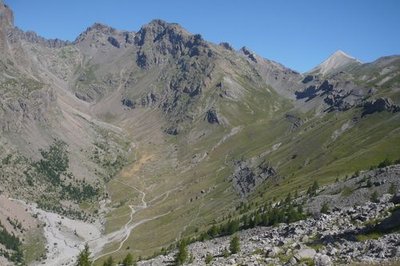
Les deux versants du vallon de Chambran - Marie-Geneviève Nicolas  Geology and geography
Geology and geographyThe front of the nappes
The two slopes of the Chambran valley are very different: the right bank, minerals are very present. There are granites and gneiss making up the crystalline base of the Ecrins massif. On the left bank, the prairies are sandstone and chalky. These are part of the glacial thrust sheet: they are ancient sediments deposited mostly to the East, in the Alpine ocean, then carried here by compression at the time of the formation of the Alps.
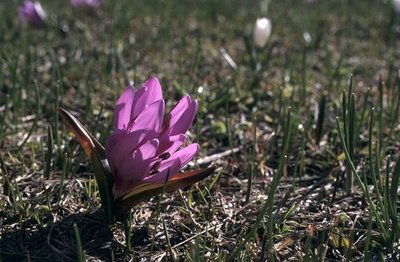
Le bulbocode printanier ou colchique de printemps - Marie-Geneviève Nicolas - PNE  Flora
FloraSpring meadow saffron
May in Chambran valley: the snow has only just melted, when it appears, almost hiding all the grass yellowed by the winter, a pink carpet of Spring Meadow Saffron. The Spring Meadow Saffron, is a plant close to the Colchicaceae (but flowers in Spring as its name indicates!) it can be distinguished from the crocus, with whom it grows, by its pink open flower ; the crocus flower is mauve or white and closed.. The first belongs to the lily family and the second to the iris family.
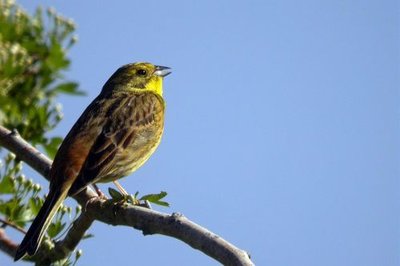
Bruant jaune - Damien Combrisson - PNE  Fauna
FaunaYellow Hammer
In the bottom of the valley, at the beginning of the summer, you will certainly hear, coming from the summit of a bush or a tree, the song composed of several notes in the same tone followed by a final higher or lower note... With binoculars, you can distinguish a bird with yellow and white feathering, the well named Yellow Hammer. It is a male, the female is more discreet as much in song as in its feathers! Listen well: Beethoven must have been inspired by this song when composing the first notes of his 5th symphony!
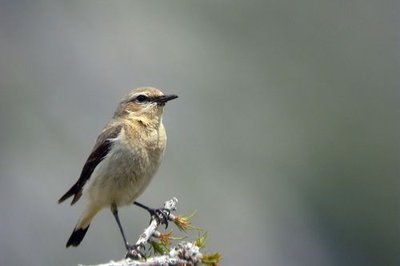
Traquet motteux - Damien Combrisson - PNE  Fauna
FaunaNorthern Wheatear
Perched on a rock, a bird is alarmed it cries ouit ouit or tchac tchac. You can recognize it straight away thanks to its white rump and its tail with a black backward T: a Northern Wheatear. It is a migratory bird that needs open spaces with big rocks under which the female can build its nest.
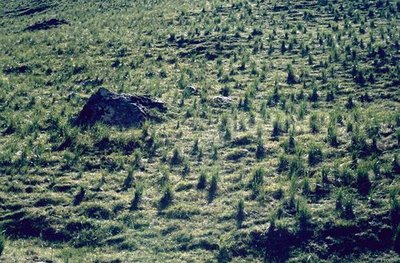
Fétuque paniculée - Manuel Meester  Flora
FloraEast Alpine Violet Fescue
Right up to the cabin, you can distinguish in the surrounding prairies big tufts of tough grass, the East Alpine Violet Fescue. This poaceae (a grass) is in competition with all the other plants and takes up a lot of space. Formerly, mowing limited its development and encouraging other meadow plants for foraging. At the moment, this plant must be grazed early in the season when the leaves have not yet hardened after this the animals refuse them.
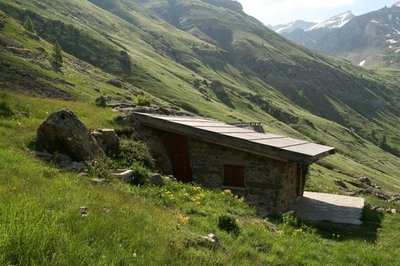
Cabane pastorale du vallon de l'Eychauda - Marie-Geneviève Nicolas - PNE  Architecture
ArchitectureEychauda Pastoral Cabin
This cabin shelters the shepherd from June to September. In order to not be carried away by the avalanches, it has been built under the shelter of the big boulder and it has a pitched roof that extends along the slope of the mountain. Another cabin situated above the Chambon valley makes it possible for the flock to exploit the supply of grass over the weeks.
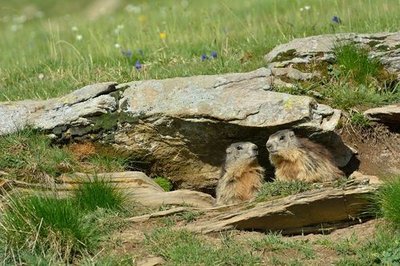
Marmottes dans leur terrier - Mireille Coulon - PNE  Fauna
FaunaMarmot
If you do not leave too late, you are likely to be able to see the marmots. They like the grass where they can dig their burrows. Stay discreet, do not try to approach them, you will disturb them. Don’t expect to see them in the hottest part of the day: it is much too hot to go out and there are too many people around!
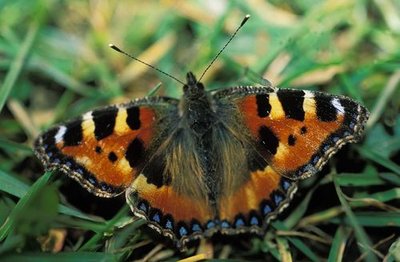
Petite-Tortue ou Vanesse de l'ortie - Jean-Pierre Nicollet - PNE  Fauna
FaunaSmall Tortoiseshell Butterfly
You will see plenty of nettles around the pastoral cabin! It is a plant living on soils full of nitrogen, which comes from the urine and the excrement of the moutons spending the night here. The small tortoiseshell caterpillars love to eat their leaves; the name in French refers to the caterpillar not the butterfly! The butterfly, also called the small tortoiseshell, can be from March onwards because it is rare for adult butterflies to hibernate.
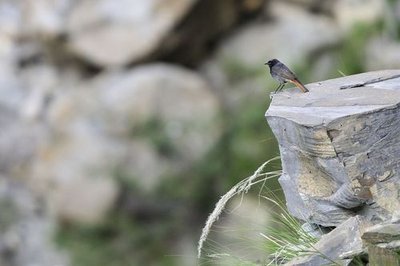
Rougequeue noir mâle - Mireille Coulon - PNE  Fauna
FaunaBlack Redstart
Even if it is well known in an urban environment, the Black Redstart is originally a mountain bird which has been able to adapt to other environments, as long as there are walls for it to build its nest! It is very present in the Chambran valley, arriving early in Spring, leaving late in Autumn. This Black Redstart is often semi migratory and is happy to join the vallies or the South of France in winter.
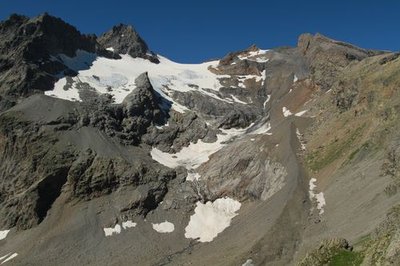
Le glacier de Séguret Foran - Marie-Geneviève Nicolas - PNE  Geology and geography
Geology and geographyGlacial terrain
With a long flat bottomed valley, its cross cliff retaining the lake, the recent moraines behind these and at the bottom, the Séguret-Foran lake, the terrain is typically one modelled by the glacier. Large quaternary glaciations, small age for ice and for the current glacier have left, as they moved away, the characteristic marks of their passage.

Chocard à bec jaune - Mireille Coulon - PNE  Fauna
FaunaYellow Billed Chough
If you picnic beside a lake, you will certainly be visited by these black birds with yellow beaks and red feet: The Choughs. Wrongly called choucas (which live at a lower altitude), sociable birds that live in groups, they are great acrobats and very opportunistic. Their diet is varied, from vegetable peelings to cheese rinds!
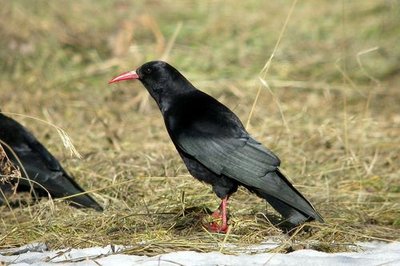
Crave à bec rouge - Damien Combrisson - PNE  Fauna
FaunaRed Billed Chough
Recognizable far away by its raucous cry, the Red Billed Chough (and red feet!) sometimes gets mixed up in flocks of Alpine Choughs. But they are more timid. They dominate the high mountains less than the Alpine Choughs and sometimes inhabit sea cliffs.
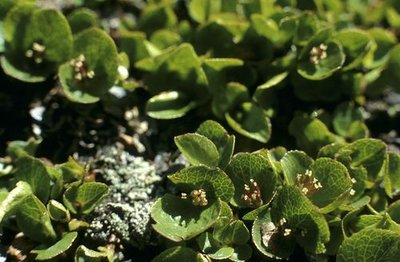
Saule herbacé - Marie-Geneviève Nicolas - PNE  Flora
FloraDwarf Willow
Around the lake the grass is short: it is an alpine lawn. In the hollows, the snow remains for a long time at this altitude and the plants have little time to flower and reproduce. Only certain plants that are perfectly adapted can survive the « snow patches », scientific term to describe this particular environment. In this way the Dwarf Willow, cousin to the Weeping Willows, is a woody plant covering the ground hardly lifting up except by its small leaves and catkins.
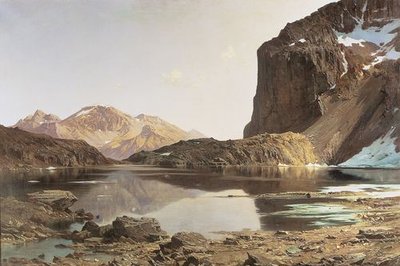
Le Lac de l'Eychauda, Laurent Guétal - © Musée de Grenoble  History
HistoryLe Lac de l'Eychauda, Laurent Guétal
In the second half of the nineteenth century, Laurent Guétal was one of the most prominent painters of Dauphiné landscapes. In 1886 he painted a picture entitled Le Lac de l'Eychauda, from a study he had completed in situ a few years earlier at 2,514 metres above sea level. Painted in three weeks for the Salon, the work was favourably received and earned the artist two medals. While the bottom of the painting is presented as a succession of horizontal bands, at the top the sky is set against the dark mass of the mountain. The attention paid to detail helps to reinforce the scale of this site, magnified by light.
Forecast
Altimetric profile
Recommandations
The ascent to the lake is carried out on the South-East slope, it gets hot very quickly. Do not leave too late ! In contrast, a cold wind coming from Grangettes mountain pass can suprize you when you arrive. Take warm clothes!
Information desks
Vallouise Park house
, 05290 Vallouise
Information, documentation, models, exhibitions, screenings, product sales and works of the Park. Guided tours for school, reservation required. The new Park House opened in Vallouise since June 1, and offers visitors an interactive permanent exhibition inviting to explore the area and its heritage. A temporary exhibition space will allow a renewed offer. Finally, the device is completed by an audiovisual room to organize screenings and conferences Free admission. All animations of the Park are free unless otherwise stated.
Transport
Station SNCF at l'Argentière-la-Bessée (L'Argentière-les-Ecrins) then bus or taxi to Pelvoux. No shuttle service to Chambran.
Access and parking
At Vallouise, follow the direction of Pelvoux. At Sarret hamlet, turn right in the direction of Eychauda up to Chambran car park (signposts at this site). Road closed in Winter.
Parking :
Source

Report a problem or an error
If you have found an error on this page or if you have noticed any problems during your hike, please report them to us here:


